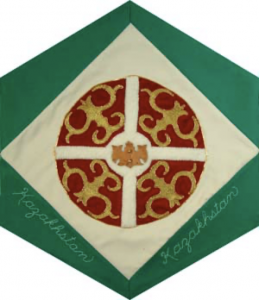Kazakhstan

The Block
A small medallion, typical of Kazakh leatherwork, rests on felt at the centre of this block made by Aselka Syzdykova and Zukhra Qamar. Felt is used extensively to cover the exterior of yurts (portable, round tents) inhabited by Kazakh nomads. It is used as well in the making of traditional kalpaks (hats), rugs and wall hangings. The felt bars are positioned over a circular velvet background to reflect the characteristic construction of the dwellings; a design that is also present on the national coat of arms. Velvet is a popular material used in the making of traditional clothing, which is worn to celebrate holidays and special occasions. The intricate ram’s head pattern, stitched in each portion of the circle, is a favoured motif incorporated into many Kazakh textiles, such as the woven tekemets (carpets) that have become prized works of art.
Cultural Profile
Kazakhstan is the ninth-largest country in the world. Almost all the nation is located in the west central part of Asia, however, a small portion of the republic lies in Europe. Kazakhstan, which at one time was part of the former Soviet Union, became independent in 1991. Almaty is its largest city and was the capital until it was replaced by Astana. It is known for its many apple orchards and was once a stop on the Silk Road (an overland trade route between China and Europe).
Central Asia’s richest country, Kazakhstan contains some of the world’s largest mineral deposits, including iron and gold, as well as large reserves of oil and natural gas. It is also one of the world’s most under-populated nations. Kazakhs make up more than half the population, followed by Russians. Kazakh, a Turkic language, is the national language, although many Kazakhs speak Russian, which has been officially called the “language of inter-ethnic communication.”
Historically, Kazakhs, which means ‘free’ and ‘independent’, were nomads who raised livestock on the country’s northern steppes. This nomadic life meant that hospitality was, and still is, the most important value in Kazakh culture. Guests are always welcomed as bearers of news and a source of entertainment and consequently are offered tea, meal and a bed if needed. As a result of the reduction in grazing land caused by the growth of cities and industries, most people have settled in rural villages or urban areas. Cattle and sheep however, remain important to the economy and some Kazakhs still follow a semi-nomadic way of life for part of the year. Horse-riding is also an important part of Kazakh life. A good example of this is the popularity of Kyz kuu, which means ‘catch the girl’. For this sport, a girl astride a galloping horse races to escape a boy chasing her on his horse. If the lad catches up to her, he’s entitled to ‘steal a kiss’ from her, but if he doesn’t, she can choose to give him a good crack with her whip!
Many arts and crafts have their origins in the nomadic lifestyle of the early Kazakh people. They developed techniques to build and easily transport large, comfortable yurts. Each yurt served a specific purpose, whether a kitchen, bedroom, or gathering place. These dwellings still dot the countryside. They are beautifully adorned inside with brightly coloured felt rugs and wall coverings. Embroidery adorns the traditional costumes of the country. These are skillfully fabricated from the fur, hide and wool of their flocks.
Social life in Kazakhstan centres on the family. Grandmothers, or azihes as they are known, have special bonds with relatives, who feel azihes are the glue that holds their society together. Cultural traditions reflect strong Russian and Islamic influences. Music is an integral part of Kazakh life and aquins (singers) still travel around the country performing dramatic recitations of tales and poems in song form. Traditional instruments include the dombyra (similar to a lute) and the kobiz (like a viola).
People have been coming to Canada from Kazakhstan for many years and there are currently almost 4,000 Kazakh residents living in Canada.
Sponsor: Martintown Animal Hospital
